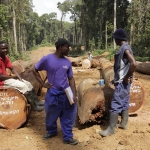INDIA: Battle over Indian steel mills
Twenty years ago Kalinga Nagar, in the eastern state of Orissa, was a quiet area of paddy fields and forests, its villages relatively untouched by the mainstream of Indian life.
In another 20 years' time, according to a government plan, it will become a 13,000 acre industrial centre, with more than a dozen factories producing 25 million tonnes of steel a year.
There will be an airport, a hospital, schools and new houses supplied with water and electricity.
It is one of many ambitious schemes to make isolated and undeveloped corners of India economically productive.
Compensation
It is home to tribes people known as adivasis or "original inhabitants", who are among the poorest of India's rural poor.
All kinds of promises have been made, but these factories only bring us misery
Farmer Nagendra Chakradhar
But the area is also blessed with abundant quantities of untapped minerals, and has improving transport links to the outside world.
"It is simply one of the best places on earth to produce steel," a local government official boasted.
It is not far from where a South Korean firm, Posco, last year promised to build a steel plant costing $12bn - the biggest ever single foreign investment in India.
The only problem is that many of the people living in Kalinga Nagar, near the town of Jajpur, do not want to make way for the new factories.
They say the government is not offering them enough compensation, and that guarantees of jobs and resettlement cannot be trusted.
"All kinds of promises have been made, but these factories only bring us misery," farmer Nagendra Chakradhar said.
"If the government really wanted to help us they would give us water to irrigate our fields, and not bother with this industrialisation."
Deaths
On the other sides of the valley from Nagendra's farm, three giant plants are already up and running, their chimneys, gas flares and trucks throwing smoke and dust up into the air.
But on the first Monday of the year, when a fourth company, Tata Steel, started work on clearing land it had acquired, angry villagers armed with bows, arrows and axes, tried to block it.
There are different accounts of what happened next, but by the end of the day one policeman and 12 protesters had been killed.
Patches of dried blood still mark the battlefield, which has now been abandoned by the steel company's bulldozers to the villagers' cows and buffaloes.
"One of the men was shot in the leg. This is where he fell, and where the police came and kicked him to death," local boy Ajay Deori said, pointing to a flattened patch of earth.
Since then, the chief of police has been transferred, a government inquiry set up and compensation promised.
The president of India's governing Congress Party, Sonia Gandhi, was among the first politicians to visit the site.
"My sympathies are with the bereaved families," she said.
But there were reports that bodies had also been mutilated, and the area remains tense.
'Duped'
Beside the field where some of the victims were cremated, villagers have dragged tree trunks and rocks into the road to block traffic to and from Kalinga Nagar.
"The government has duped the people," village leader Chakradhar Haibru protested. "The blockade will continue until our demands are met."
Most important of these is that payments for the land are stepped up.
Mr Haibru complains that the government made a huge profit on the land.
He alleges it bought from the villagers more than a decade ago at one price, then sold the site to Tata Steel for a much higher one.
Mr Haibru also complains that many people did not receive any money since their traditional rights to the land were not recognised.
"First the government should give us the records of our rights to the land. Only then will we negotiate with them."
The Orissa government said the killings were a tragic mistake, and that it was now listening to the villagers' demands.
"We are open to any kind of suggestions for the betterment of the stakeholders as well as for the displaced people," the chief official for the area, Dr Arbind Padhee, explained.
He added that state ministers would soon consider increasing payments for the land, and make sure the factories provided the jobs they promised.
'Pro-poor'
Community leaders in the region warn that unless the government gets it right, protests could spread.
There are big industrial developments planned across mineral-rich Orissa and the rest of India's "tribal belt".
Adding to the pressure are the Naxalites, an armed Maoist insurgency operating in eastern India, which claims to be fighting on behalf of marginalised rural communities.
The government argues the best way to improve the lives of the tribal people is for the developments to go ahead. Dr Badhi described the Kalinga Nagar plan as "pro-poor".
"The protection of the tribals as well as the displaced people must be our priority. The benefits must trickle down to the needy, to the poor, to the displaced persons," he said.
- 181 Food and Agriculture
- 182 Health



